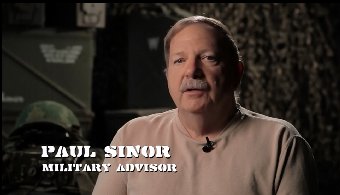Colonel Paul Sinor

(Picture taken from the Fabulous
Films Tour of Duty Documentary)
Answers kindly supplied by Colonel Paul
Sinor who worked on Tour Of Duty
as the shows Technical Advisor.
Questions & Answers
Q/.Did you work on just the first series or all three of them ?
A/. I worked on all the episodes filmed in Hawaii. When the series moved to Los
Angeles, I went to the set and worked on one episode, however it was in an unofficial
basis.
Q/.
The episode “Under siege” has the Firebase being
basically wiped out by explosions as the men try to survive in the bunker, was this
episode based on an a specific event in the war ?
A/.
UNDER SIEGE was not based on a specific incident, however many small fire bases
like ours were constantly under attack, so this was a realistic interpretation of actual
events.
The base was not destroyed as it appears in the episode. We did blow up a lot of
smaller locations, (towers etc) that were built for this episode, but the firebase
remained essentially intact.
The firebase was built by Army Engineers using Vietnam plans, but conforming them to the
needs of the production. The night scenes in any TV or feature have their own unique
set of requirements. For me, the biggest challenge was having the proper amount of
mortar illumination fire during the battle. As I mentioned earlier, we were on an
actual firing range so we could fire "live."
With mortar rounds in the air, there was no chance for a retake....Steve Posey, who was
our Director of Photography directed this episode. It was his debut, (I think) as a
director and he did an outstanding job.
Q/. Which episode was the most technically challenging for you to do ? And for what reasons
?
Challenging? Yes. Impossible? No.
Q/. If I may ask about your military career , could you tell me a few details ?
A/. I was what is known as a "Mustang," in that I was an enlisted man who
got a commission through Officer's Candidate School. I served in positions from
Platoon Leader through the staff of the Assistant Secretary of
Defence. I attended
OCS, Officer's Advance Course, Counter-Guerrilla Warfare School, Airborne School, Special
Forces Officers Course, Command and General Staff College.
Q/. The army gave its full backing to the first series of “Tour Of
Duty” and then apparently was not happy with some of the second season and withdrew
its support for the show other than checking the show scripts , do you know anything about
this matter ?
A/. When Tour Of Duty moved to California the series took a different approach
which the military felt they could not support.
Q/. Out of all the episodes you worked on you must have a favourite , which
one and why ?
A/.Since I had an intimate involvement in each episode, asking my favorite is
akin to asking a parent which is his favorite child. I liked them all and enjoy
watching then in re-runs even now.
Q/. In the episode the
Paradise Lost the "guys" make contact with a Montagnarde tribe, how did this storyline come about ?
A/. The story line in Paradise Lost, (I think) was based loosely on
rumours of
Americans, especially some who were in Special Forces who had "gone native" in
Vietnam and refused to come home. To my knowledge, this is like Bigfoot or Nessie
and makes for a good story, but cannot be proved or disproved.
Q/. Did you suggest any ideas about episode plot lines ,that made it to screen
?
A/. I made suggestions on each episode as that was my job. Mine were done in
production meeting to ensure accuracy and on the ground when one of the actors asked how
something should be done in order to make it more accurate.
CopyrightÓ2021 Craig Blackmore. All rights Reserved.